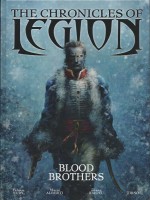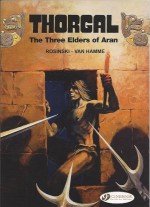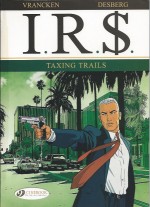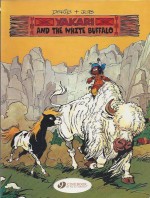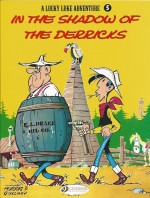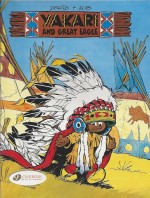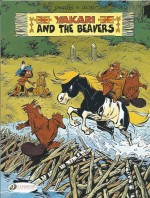
By Derib & Job, translated by Erica Jeffrey (Cinebook)
ISBN: 978-1-905460-09-0
Tales of untamed the American West have always fascinated fans in Europe, and none more so than the assorted French-speaking regions who also adore comics. Historically we Brits have also been big fans of sagebrush sagas and the plight of the “noble savageâ€â€¦
In 1964, Franco-Swiss journalist André Jobin founded the children’s magazine Le Crapaud à lunettes and began writing stories for it under the pseudonym Job. In 1967 he hired fellow French-Swiss artist Claude de Ribaupierre, who had begun his career as an assistant at Studio Peyo (home of Les Schtroumpfs) where he worked on a number of Smurfs strips for venerable weekly Spirou.
As “Deribâ€, he co-created with Job The Adventures of the Owl Pythagore and two years later they struck pure gold with their next collaboration.
Launching in 1969, Yakari whimsically and enchantingly related the life of a young Sioux boy on the Great Plains; sometime between the introduction of horses by the Conquistadores and advent of the modern White Man. It’s a generally bucolic existence in tune with nature and free of strife, punctuated with the odd crisis generally resolved without fame or fanfare by the little lad who is smart, compassionate, brave… and can converse with all animals…
Derib, equally fluent and brilliant in both the enticing, comically dynamic “Marcinelle†cartoon style and a devastatingly compelling meta-realistic action illustration form, went on to become one of the Continent’s most prolific, celebrated and beloved creators through such groundbreaking strips as Celui-qui-est-né-deux-fois, Jo (the first comic on AIDS ever published), Pour toi, Sandra and La Grande Saga Indienne).
A large and significant proportion of his stunning works over the decades reverberate with Western themes and magnificent geographical backdrops and landscapes, and Yakari is considered by many to be the feature which catapulted him to mega-stardom.
Yakari chez les castors was the third collected European album, published in 1977 as the strip continued to grow in prominence and popularity. A year after this release the feature began running in Tintin, subsequently spawning two animated TV series (1983 and 2005), all the usual merchandising spin-offs and achieving monumental global sales of the 38 albums (in 17 languages) to date. The most recent, Yakari et la tueuse des mers was released in 2014.
In 2005 the first translated volume – Yakari and Great Eagle – was part of Cinebook’s opening salvo in converting British audiences to the joys and magic of Euro-comics and the English language assortment now numbers an even dozen, all still readily available for you and your family to enjoy.
Yakari and the Beavers begins in summer as the nomadic Sioux make camp at a confluence of rivers. The children are playing, testing their strength, speed and archery skills, but with burly Buffalo Seed winning most of the honours – and the fascinated attention of pretty Rainbow – soon physically less-developed Yakari slopes off to cavort with his faithful and forthright pony Little Thunder.
As the pair romp and swim in the river they come across a strange wooden construction ranging from bank to bank and unexpectedly arouse the ire of an excitable beaver named Thousand Mouths. He is the impatient and irascible foreman of a band of buck-toothed brethren, determined to finish the family home in record time, but his fellows are far less enthusiastic and when one – dubbed Linden Tree – spots the palomino it starts a stampede of rodents who would all rather ride horses than chew timber and move mud. While they’re all goofing around their boss is going ballistic and a wise old beaver is teaching a rapt Yakari everything he needs to know about dam-building…
After more idle days in the camp Yakari’s thoughts return to the beavers and soon he and Little Thunder are heading back to the dam. En route however they are distracted by an astonishing noise and follow it to discover extremely ambitious beaver Double-Tooth far from the river and attempting to chew down a colossal tree all alone…
The eager beaver soon confides his dreams of being a sculptor but their conversation is curtailed when a bad tempered grizzly bear wanders up and menaces little straggler Wild Rose.
With the ursine interloper clearly not amenable to reason Yakari drives the surly brute off with a rough-hewn jousting lance rapidly gnawed into shape by Double-Tooth’s flashing gnashers…
On escorting the kits back to the river Yakari is astounded to see the progress made in the wood-and-mud abode and is delighted to be asked to help. In actual fact most of the assistance comes from hard-pressed Little Thunder who reluctantly becomes the engine transporting trees and saplings from the woods to the river…
Returning late to camp Yakari is observed by Rainbow who desperately wants to know what her friend is up to. Next morning she invites herself along as they return to the Beaver Lodge and cannot understand why, in the midst of listening to the hairy toilers chattering, Yakari spurs his pony away and races away.
Mounted behind him she listens incredulously as the boy explains that little Linden Tree is missing and then makes him backtrack to the really important bit. Yakari understands and can talk to all birds and beasts…
Racing downriver the children are soon joined by Yakari’s totem animal sagacious Great Eagle who provides a telling clue to the lost beaver’s whereabouts. However after daring subterranean depths the little brave eventually finds his lost friend but is himself trapped. Happily the artistic skills of late-arriving Double-Tooth prove invaluable in devising a climbing device and soon everybody – even utterly bemused Rainbow – are all celebrating back at the Lodge.
With things back to normal the irrepressible frustrated artist corners Yakari for one last secret project and a few days later the busy beavers are all astounded to see Double-Tooth’s river-borne aesthetic magnum opus poled into the lee of the dam by the proud Yakari…
The exploits of the valiant little brave who can speak with animals and enjoys a unique place in an exotic world is a decades-long celebration of joyously gentle, moving and inexpressibly entertaining adventures honouring and eulogising an iconic culture with grace, wit, wonder and especially humour.
These gentle sagas are true landmarks of kids’ comics literature and Yakari is a series no fan of graphic entertainment should be without.
Original edition © 1977 Le Lombard/Dargaud by Derib + Job. English translation 2005 © Cinebook Ltd.

